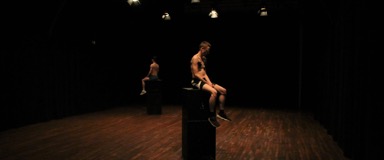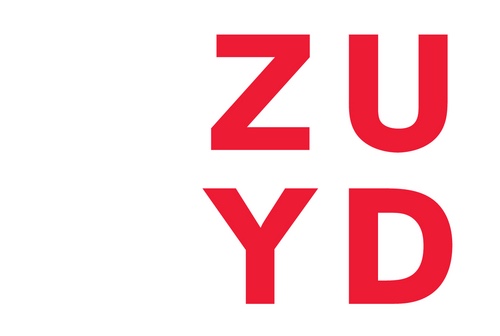Intermediality in Live Performances
Intermediality is at the core of the artistic strategy of the research group Technology Driven Art.
Intermediality infects established media with artistic strategies from the media. The results in an intermedium: a place where new artistic possibilities can be explored.
As an established opera director and stage designer, head of research Peter Missotten is an expert on infecting the stage with digital media.
This expertise is used in a hands-on approach towards teaching Performance Art. This resulted in 2016 and again in 2021 in a "Special Distinction (Bijzonder Kenmerk)' for the Toneelacademie Maastricht for the integration of Intermediality in it's curriculum.*
 Heartscore | Anthony van Gog 2021 https://veem.house/productions/hearstcore-anthony-van-gog/
Heartscore | Anthony van Gog 2021 https://veem.house/productions/hearstcore-anthony-van-gog/The research group Technology Driven Art supports a wide variety of intermediate performances, mostly instigated by students.
The artistic research takes place in the actual confrontation of the art piece and the general public. It's not so much a 'work in progress' as a 'show in progress'. The aspiring artists are encouraged to make their hands dirty while exploring the artistic possibilities (and language) of upcoming technologies. This happens as much as possible without the support of outside technicians and experts: they teach themselves. This results in a flow of creative misunderstandings and 'abuse' of technology. Performances and installations find their way to th public through festivals. This approach has led to quite influential new artistic practices far beyond the scope of the 'school'.
*"Intermedialiteit wordt door de Toneelacademie helder gedefinieerd als de wederzijdse besmetting van de verbeeldingsstrategieën van twee (of meer) media binnen de context van één kunstwerk. In de opleidings- strategie en in het curriculum is zichtbaar aandacht voor deze vorm van Intermedialiteit. Zowel op papier als ook in de praktijk leren studenten over de randen van het eigen mediale gebruik heen te kijken. Hierdoor worden studenten niet alleen creatief in de omgang met het eigen medium, maar weten ook verbindingen met andere media te leggen. Dit is van toegevoegde waarde voor het functioneren als acteur of vormgever. De uitwerking van Intermedialiteit is het sterkst in de afstudeerrichting Performer, de uitwerking in andere afstudeerrichtingen kan worden vergroot. De commissie stelt op grond van de gesprekken en de onderlig- gende documentatie vast dat de opleiding voldoet aan alle drie de criteria voor een bijzonder kenmerk. Daarom adviseert de commissie het bijzonder kenmerk Intermedialiteit toe te kennen aan de bacheloroplei- ding Theater van Zuyd Hogeschool."
Verslag van de beperkte opleidingsbeoordeling 16 en 17 juni 2021 van de Bachelor Theater Zuyd Hogeschool (Toneelacademie Maastricht)
International research project on intermediality at the Toneelacademie Maastricht
TO BE OR NOT (May-June 2020)
A live performance project questioning our disapearance into virtuality, open for international theatre students.
this research projectbuilds on the collaboration in the PLETA project - Platform of European Theatre Academies
a research project by Peter Missotten and Woody Laurens (Toneelacademie Maastricht)
Application form can be found here
INTERDISCIPLINARITY AND INTERMEDIALITY (May-June 2017)
resulting into 'Der Untergang der Titanic'
this research is part of the PLETA project - Platform of European Theatre Academies
a research project by Peter Missotten and Woody Laurens (Toneelacademie Maastricht)
3D SCANNING FOR THE STAGE (part 2 - May-June 2016)
resulting into 'HADES' a performance as part of the PLETA project 'An Odyssea'
a research project by Peter Missotten and Woody Laurens (Toneelacademie Maastricht)
with Diederik Kreike, Caro Derkx, Tim Bijtelaar, Hendrik Kegels and Amanda Dekker.
3D SCANNING FOR THE STAGE (part 1 - May-June 2015)
a research project by Hans Lasschuit and Woody Laurens (Toneelacademie Maastricht)
with Kaz Schoonebeek, Evelien Cannaert, Stijn Van Erp e.a.
In this research project, we try to find out whether virtual, 3D scanned 'actors' can be introduced in a performance, without the need for hightech stuff.
3D scanning of persons is a well established practice, especially within the Hollywood movie and gaming industry. But the machinery for it remains rather hightech and expensive, well outside the reach of a small performance company. 3D scanning in general is a booming business, but almost exclusively orientated towards the scanning of non-moving objects for the industry. Most scanners require you to sit down very quiet for quite some time, unless they are done with a huge and expensive rig of over 30 professional camera's in a dome like construction.
Is it possible to do that with a much smaller rig of cheap consumer camera's? How workable is that in practice? And how does the technology influence the artistic practice?
In this first round, several software solutions were examined - Strata Foto 3D, Autodesk’s 123D Catch, Agisoft Photoscan etc… It all didn't work out self evidently, most of times because of some tiny technical problems. Firing all of the cameras with the remote control proved to be challenging, even with IR-relay modules. And Strata Foto requires an underlay print which proved to be very unpractical for moving objects.
All in all, the research time proved to be way too short to get a decent and usable result. At the same time, the students designed a very inspiring 3D installation, as a set for the project. Somehow, thinking in 3D influenced their mind and gave them inspiration for a new kind of set design, even if the 3D scanning proved to be quite challenging.
Next year (2016) we had a second edition of the same project - this time resulting in a full fledged performance as part of the Odysseus project, where several European theatre schools showcase their specialities. It's fun thought that the Toneelacademie chooses to participate with virtual actors.
To be continued….




